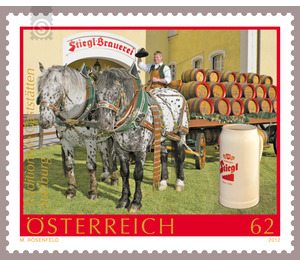gastronomy - Austria / II. Republic of Austria 2012 - 62 Euro Cent
Theme: Economy & Industry
| Country | Austria / II. Republic of Austria |
| Issue Date | 2012 |
| Face Value | 62.00 |
| Edition Issued | 400,000 |
| Printing Type | offset |
| Stamp Type | Commemorative |
| Item Type | Stamp |
| Chronological Issue Number | 2349 |
| Chronological Chapter | OOS-OE2 |
| SID | 974181 |
| In 58 Wishlists | |
With the "Stieglbrauerei", a hospitality institution in Salzburg, the "Gastronomy with Tradition" series, which started in the previous year, is now being continued in a very sympathetic way. The complacent motif of the brand shows a historic two-horse, loaded with wooden barrels beer car in front of the entrance to the Stiegl brewery, as well as the highly appreciated beer connoisseurs Steinkrug with the unmistakable Stiegl logo. The story: The first written mention of the once called "Brew am Stiegl" (also "Brew at the stairs on the Gstetten") goes back to 1492, the year in which Christopher Columbus America discovered. At that time, a certain Hans Peuntner inherited the brewery to the widow of his son. The brewery got its name from a small staircase that led from the brewery to the Almkanal. The old brewery served until 1909 as a brewery, then it was sold to the city of Salzburg, which in turn sold part of the building to the Ursuline convent, which was built at this point a girls' gymnasium. Interesting: Today, as then, again a small staircase that leads from the Gstättengasse to Anton Neumayr Square, available here. In 1819, Johann Schreiner bought the Stiegl brewery and, together with his wife, set up a Märzen cellar in the Festungsgasse. In 1838, the Schenk concession for the garden and storage cellar was acquired. In 1840, with the further expansion of the cellar, twenty years later, in 1860, a second one was created. In 1901 it was rebuilt by the architect Jacob Ceconi and provided with pretty bay windows, gables and turrets. The last conversion was finally in 1926 by a Munich architect named Franz Zell. Today, the Stieglbrauerei is the largest privately owned brewery in Austria and produces about one million (!) Hectoliters of beer per year. The most important sales areas are Salzburg, Upper Austria and Tyrol. Around 15,000 customers are supplied with Stiegl beer, of which 43% are from the hospitality industry and 57% from various retail chains. After all, 34% of the beer output is in barrels, 61% in bottles and only 5% in cans. Austria's market share of Stiegl is approximately 11%. One thing is certain: when one travels to Salzburg, the stop at the Stieglbrauerei is, to a certain extent, a pleasurable and compulsory program that has to be completed. The museum "Stiegl-Brauwelt" is also worth a visit, where you can see everything that has something to do with beer, from the raw materials to the production and the history of the Stiegl Brewery.


